Last-Minute NYC Holiday Gift Guide 🎁
We’ve created a holiday gift guide with presents for the intrepid New Yorker that should arrive just in time—



Since the 1980s, the MTA has installed hundreds of site-specific works of art throughout the subway system. These pieces of art have been designed by world-famous artists in order to create a beautiful underground art museum for the millions of daily subway riders. The Arts for Transit program was a continuation of the philosophy established by the founders of the subway system that “every design element in the system should show respect for our customers and enhance the experience of travel.”
The original subway art was composed of terra cotta and mosaic and often depicted scenes that once graced the surrounding neighborhood. According to one account, they served as a map for tourists and the illiterate. Here are some of the best examples that can still be found in some of the subway’s oldest stations. To see some of these pieces of art up close, join us for an upcoming Underground Art in the NYC Subway tour:
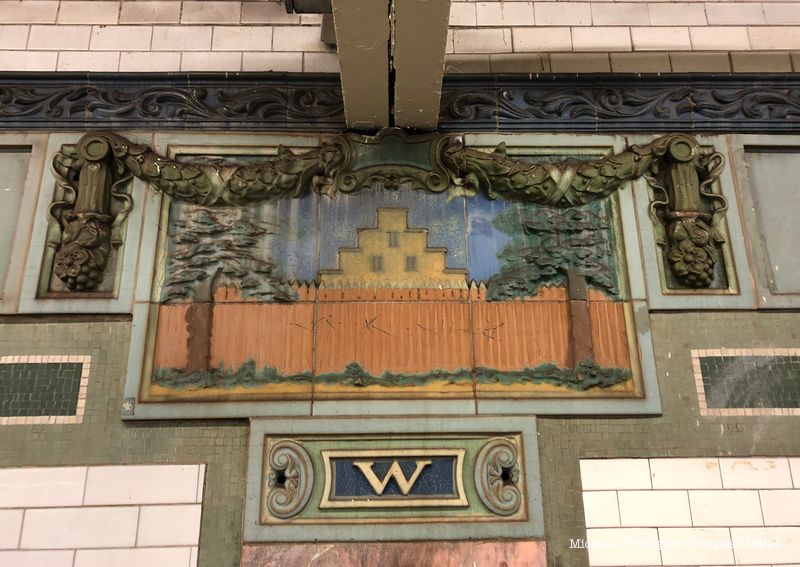
The Wall Street IRT subway station contains mosaics that depict an image from the founding days of New York City. The foreground depicts the eponymous wall that was constructed by the Dutch to keep the British out. In the center is what appears to be a stereotypical Dutch stapled colonial house. The wall began as a picket fence in 1653 before the Dutch slowly expanded it to a 12-foot-high barrier over the years. Unbeknownst to most, the wall was almost destroyed by pigs!!!
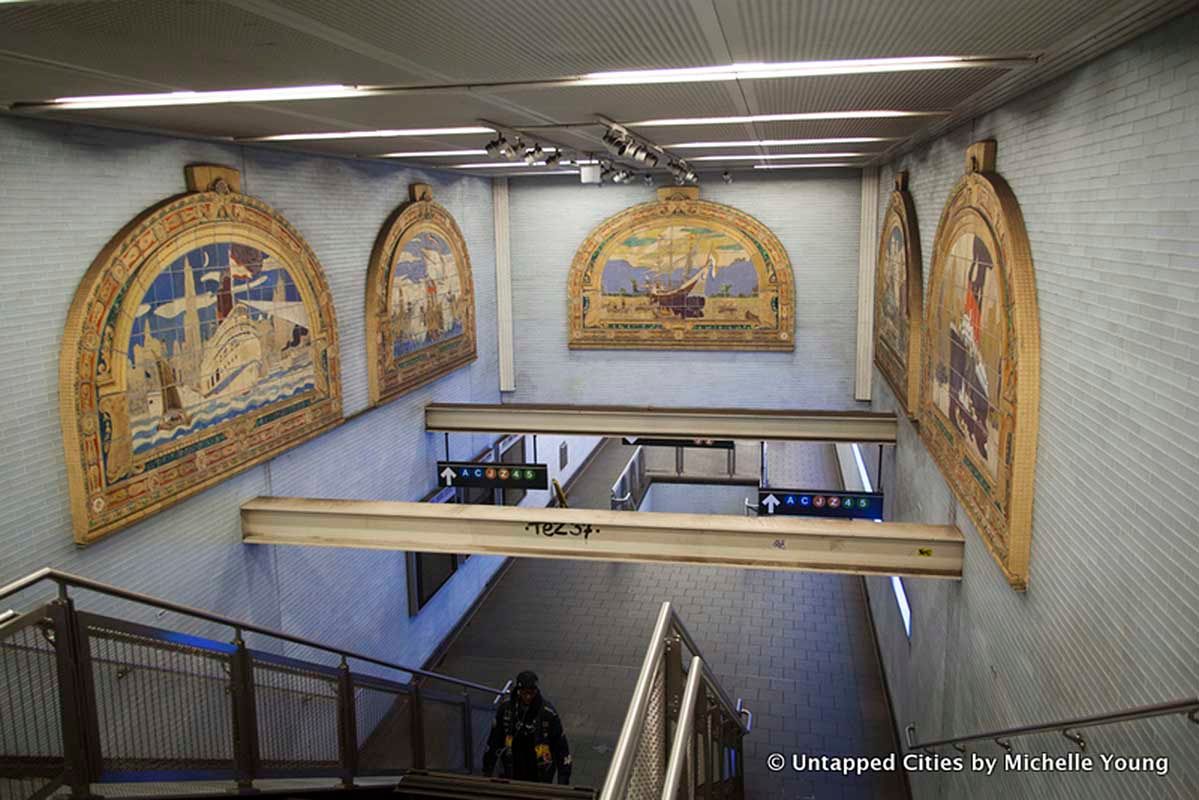
The Fulton Street IRT subway station‘s mosaics honor the station’s namesake, Robert Fulton. Fulton, with backing from Robert R Livingston, developed the first commercially successful steamboat. Pictured above is the North River Steamboat (today known as the Clermont) which left New York City on August 17, 1807, on its maiden voyage to Albany. The original ship was retired in 1814 and its whereabouts remain a mystery. Make sure to check out the rest of Untapped New York’s finds inside the Fulton Street Subway Station, including historic pieces moved from elsewhere.
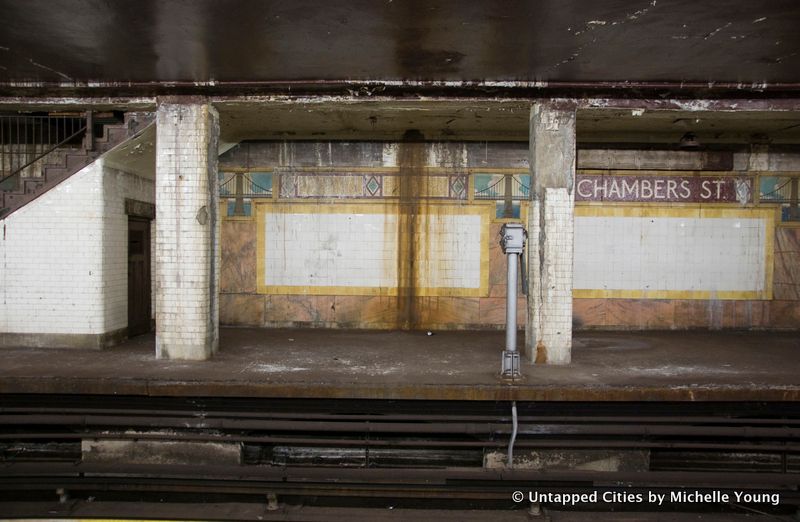
The Chambers Street BMT subway station has a few terra cotta depictions of the Brooklyn Bridge. It is surprising that the bridge is not shown from its more iconic front view. The Brooklyn Bridge, which was designed by John Augustus Roebling and opened in 1883, remains a favorite of New Yorkers and tourists alike. However, most are unfamiliar with these 10 Secrets of the Brooklyn Bridge.

The Chambers Street IRT Subway Station possesses terra cotta images of Kings College. The tiles depict two robed figures walking along a path towards a three-story, red-brick, Federal-style building. The structure has rows of windows and is topped by a weathervane and a cupola that touches a blue sky. The building is College Hall, which was located between Murray and Church Streets near Park Row and constructed in 1760. During the Revolutionary War, King’s College closed, and the hall was transformed into a hospital. After the war, King’s College was renamed (or became depending on who you ask) Columbia College, which continued using College Hall until the school moved in 1857 to a campus in Midtown. That same year, the building was demolished.
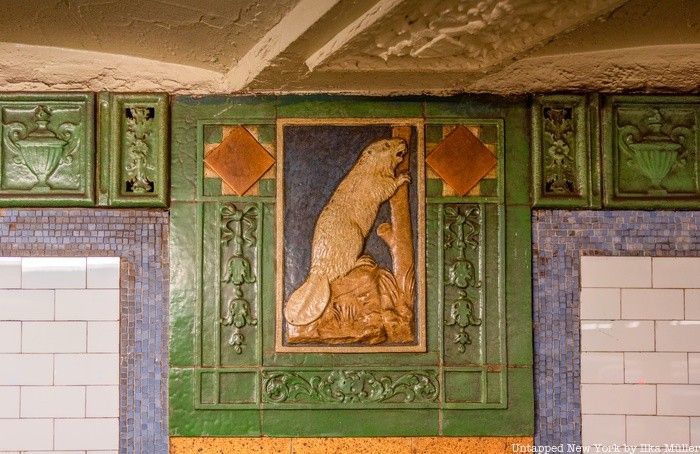
The terra cotta panels at the Astor Place IRT Subway Station are a small reminder of the wildlife that was once populated New York and much of the United States until the 19th century. The beaver is especially fitting in this station since John Jacob Astor, the station’s namesake, became the first American multi-millionaire from the beaver -pelt trade. While you are there, make sure to check out the station’s vintage subway entrance.
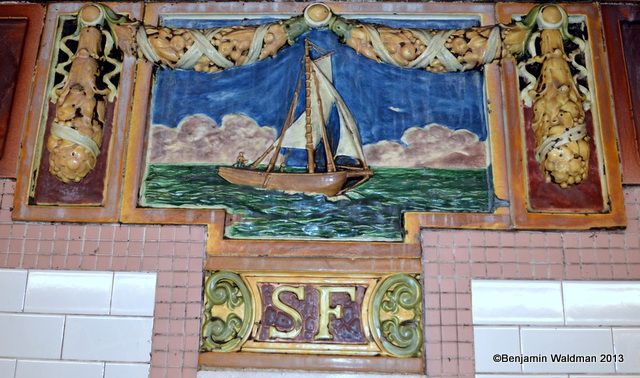
The South Ferry IRT Subway Station contains tiles depicting a sloop (or some similar type of boat) on a serene body of water with clouds in the horizon. It is a reminder that this is the only station with a direct rails to ship transfer (Staten Island Ferry Terminal/Battery Maritime Building). Since the City constructed a new subway station, which is currently being rehabilitated, it is unknown how much longer you will have to view these tiles since they are located in the original IRT subway station. There are also 200-year old artifacts from a stone wall found in the station on view.
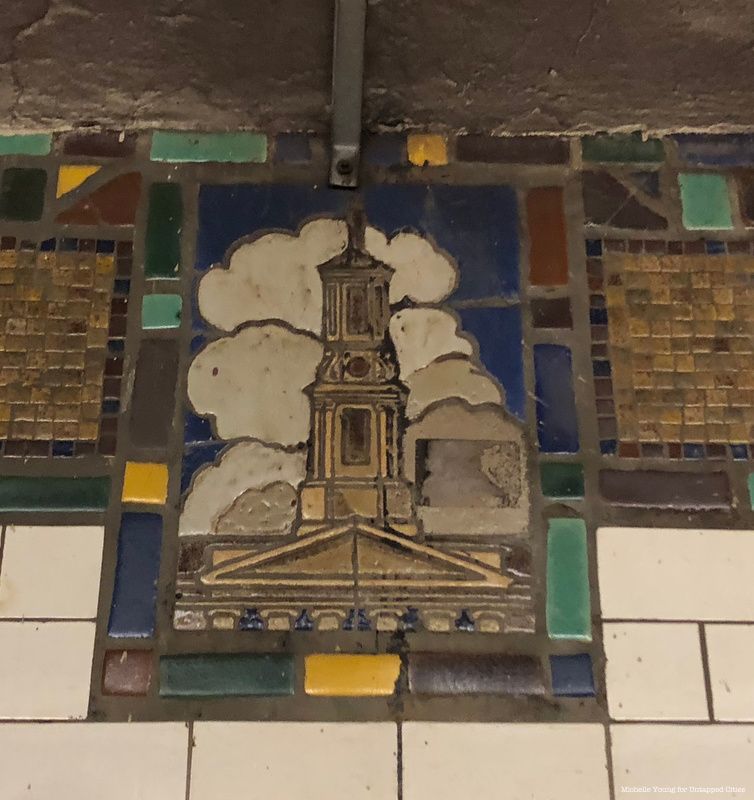
The Borough Hall IRT Subway Station has one of the most interesting and anachronistic tiles in the subways system. The tiles depict Brooklyn Borough Hall, except if you look closely, you will notice that the image is not actually the same as the building situated above the station. The spire shown in the terra cotta was destroyed in 1895 by a fire that began in a garbage can in a third-floor closet. Additionally, the statue shown surmounting the spire, while in the original plans, was not installed until 1989. If you are in the area, make sure to check out the Borough Hall Skyscraper Historic District.
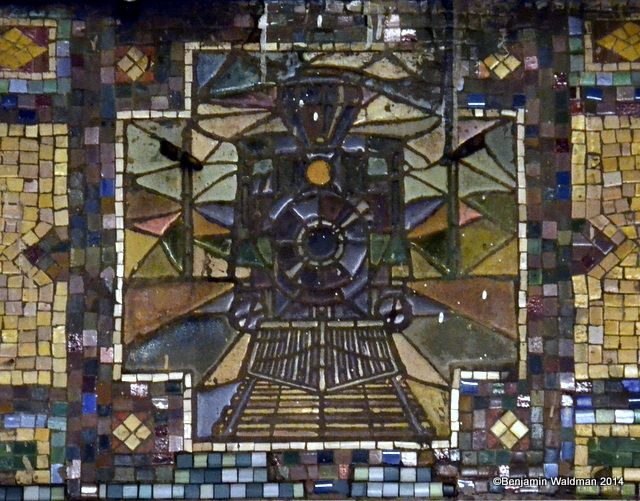
The terra cotta mosaics in the Grand Central IRT Subway Station connect the subway station with the adjoining Grand Central Terminal and its predecessor Grand Central Depot. The steam locomotives were never used on the subway and were only in operation for roughly three years in Grand Central Terminal before they became a relic of the past, making it one of the only stations to possess a contemporary (though now bygone) image.

The bridge depicted in mosaic in the 125th Street Station is one of the most obscure bridges in New York City history. In 1790, a charter was given to Lewis Morris to build a bridge that would cut the travel time to Morrisania (the name of Morris’ estate in the Bronx) from Manhattan. Morris was permitted to collect tolls for 60 years, after which ownership of the bridge would revert to the state. The bridge, a wooden bridge with a turntable draw span, was ultimately opened in 1797 and named after John B. Coles, Morris’ business partner. The Third Avenue Bridge, which has been rebuilt multiple times, was last reconstructed in 2004.

The 59th Street Subway Station aptly has terra cotta tiles that relate to the eponym of the roundabout under which the subway station is located, Christopher Columbus. The tiles depict ships, which are usually described as being Columbus’ caravel (a highly maneuverable 15th century sailing ship), the Santa Maria. However, some of the more nautically inclined individuals who study such minutia argue that it is either a different ship, or attention was not paid to detail. When the station was restored a few years ago, some early prototype tiles were discovered, which the MTA pledged to exhibit (though they still appear to be hidden). Check out our previous coverage of the hidden secrets of the Columbus Circle Subway Station.

The 137th Street Subway Station is decorated with an image of Janus or some type of three faced woman. It appears to relate to the motto of CCNY (City College of New York) which is located just east of the station. CCNY’s motto is Respice, Adspice, Prospice in Latin, which means Look behind, look here, look ahead and relates to the three provinces of scholarship.

The domed Kings County Courthouse was completed in 1865 and was the ninth iteration of the Kings County Supreme Courthouse. It was designed by the firm of Kellum and King, comprised of John Kellum and Gamaliel King. Kellum was also responsible for designing Manhattan’s Tweed Courthouse. The courthouse, which was demolished in the middle half of the twentieth century, has been all but forgotten except for those few individuals who are cognizant of what the Court Street Subway Station images represent.

The Union Square BMT Subway Station’s terra cotta is stands out for reproducing a drawing, ‘Junction of Broadway and the Bowery Road, 1828.” The drawing originally appeared in the New York Common Council Manual of 1865 and depicts the sites of Johnson & Faulkner and Ferguson Bros., on the site that would become Union Square.

The terra cotta images that decorate the Clark Street Subway station are the largest such images in the subway system. They depict the ships that frequented the once busy East River docks. It appears to be a more of a generalized view of what the neighborhood was once like and does not seem to have any historically significant ships or buildings. The Clark Street subway station also goes down as one of the most unique entrances in the system, located in the former lobby of the Hotel St. George.

The spire of St. John’s Chapel dots the walls of the Canal Street Subway Station. St. John’s Chapel was constructed in 1803 and was designed by John McComb Jr. (who was also responsible for designing City Hall, Hamilton Grange, and St. Mark’s Church in-the-Bowery amongst others). It was modeled on London’s St. Martin-in-the-Fields. The chapel was demolished in 1918 and was considered to be one of the early losses of the proto-preservation movement in New York City.

The Christopher Street Subway Station depicts the first prison that was “up the river.” It was the first prison complex in New York State. Newgate was not its official name, but it was referred to colloquially after the prison of the same name in London. In contrast to its predecessor, Newgate was influenced by the ideals of social reformers, who turned it into a house of corrections. It stood there from 1796 to 1829, when the City sold the land and relocated the prison to Sing Sing. The street grid has since been extended and the shoreline further filled in. Originally, the penitentiary had its own wharf.
Check out our previous coverage of 14 other former prisons in New York City.
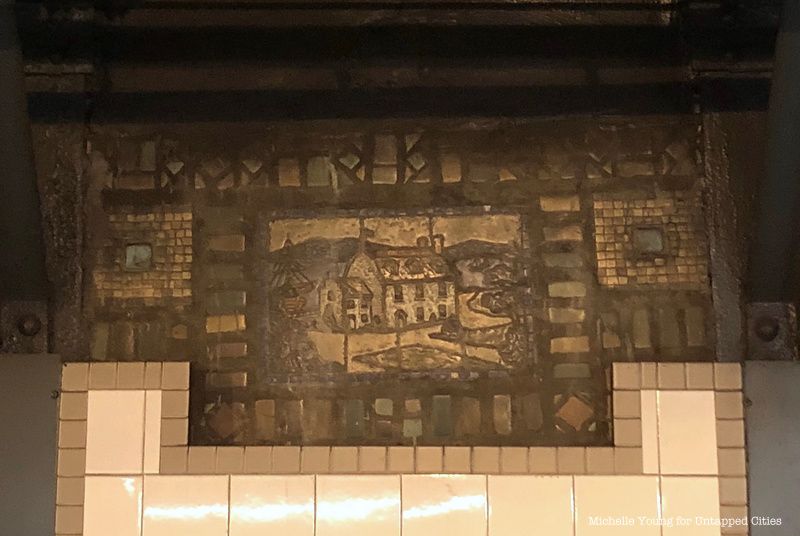
The terra cotta tiles in the Whitehall Subway Station depict the eponymous Whitehall. White Hall was erected in 1658 as Governor Peter Stuyvesant’s house on what is now the corner of Pear and Whitehall Streets. The house acquired its name from the English Governor General Thomas Dongan, who derisively called it White Hall because of its whitewashed walls. The house, which is now remembered in this subway station and street name was destroyed by fire in 1715.

The Canal Street Subway Station depicts the Stone Bridge Tavern and Stone Bridge. Next to no information exists about either. One of the only references it comes from an 1886 New York Times article which describes the area as it was in 1805-1806. It was the northern most point at which Broadway was paved and “a famous resort for…schoolboys. It was considered ‘out of town’-all north beyond as well as the immediate vicinity was country, post and rail fences dividing the land into different sized parcels. This bridge spanned a small stream which conveyed water from the Collect on the east side of Broadway (where now stands the Tombs) to the west side, where was an extensive meadow covering most of the ground from Broadway to the North River and from Lispenard-street to Spring-street.”

The City Hall Subway station possesses terra cotta tiles depicting New York City Hall’s original spire. This spire was destroyed by fire. It was the second time that the statue, cupola, dome, and roof were damaged by fire. The first fire, in 1858, was caused by fireworks celebrating the laying of the Atlantic Cable, and the second fire, in 1917, was caused by burning charcoal left unattended by workmen.
Check out the original City Hall subway station, opened as the crown jewel of the first subway line in NYC and now decommissioned.
The Cortland Street Subway Station has terra cotta tiles (which are now mostly, if not all, hidden during the station’s last renovation) that display the ferry that once ran between Cortland Street and Paulus Hook New Jersey.

The 33rd Street Subway station is decorated with eagles in recognition of the Seventy-First Regiment Armory. In 1894, the armory relocated to the southeast corner of 33rd Street and Park Avenue. That building burned down in 1902 and was rebuilt in 1905. It was modeled after the Palazzo Pubblico, Sienna’s Town Hall, and designed by Clinton and Russell. The armory was sadly demolished in the 1960s, but the eagles remain as a tribute. Since the eagles also appear in the 14th Street Subway Station and the Brooklyn Bridge Subway Station some people assume that this was because armories were located in the vicinity of those stations as well. However, this was not the case. According to Tracy Fitzpatrick in her book Art and the Subway: New York Underground, the eagles were merely recycled thereby confusing their meanings.
See some of these examples of original subway art on an upcoming Underground Art in the NYC Subway tour:
Next, discover 10 of the most unique subway art installations in NYC from MTA Arts for Transit.
Subscribe to our newsletter